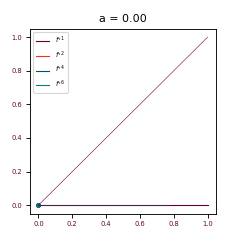6.2. Exercice 1 : illustration#
Afin de comprendre le comportement de la suite en fonction de la valeur de \(a\), voici une petite animation pour \(u_0=0.77\) avec le paramètre \(a\) qui part de \(0\) pour augmenter jusque \(4\).
On voit que pour
\(a\in[0,1]\), une seule limite possible car \(f(\ell)=\ell\) a une seule solution : \(\ell=0\). La suite converge vers \(0\).
\(a\in]1,3[\), il y a deux limites possibles car \(f(\ell)=\ell\) a deux solutions : \(\ell=0\) ou \(\ell=1-1/a\). Comme \(f'(0)=a>1\) et \(f'(1-1/a)=2-a\in]-1,1[\), la suite converge vers \(\ell=1-1/a\).
pour \(a\geq3\), les points fixes de \(f\) ne sont plus attracteurs : des cycles commencent à apparaitre. Des \(2\)-cycles avec les sous-suites des termes paires et impaires qui convergent vers les points fixes de \(f\circ f\) différents de \(0\) et \(1-1/a\). Puis cela se complique…
import numpy as np
import matplotlib as mpl
import matplotlib.pyplot as plt
from matplotlib.animation import FuncAnimation
mpl.rcParams['savefig.dpi'] = 80
plt.rcParams['figure.dpi'] = 150
%config InlineBackend.figure_format = 'svg'
%matplotlib notebook
UPS_primary = (0.38823529411764707, 0.0, 0.23529411764705882)
UPS_gris = (49/255, 62/255, 72/255)
UPS_bleu = (0.0, 0.3058823529411765, 0.49019607843137253)
UPS_orange = (0.9333333333333333, 0.20392156862745098, 0.13725490196078433)
UPS_vert = (0.0, 0.5019607843137255, 0.47843137254901963)
Show code cell source
def f(x, a):
return a*x*(1-x)
def fof(x, a, vectn):
out = []
y = x.copy()
k = 0
for n in vectn:
while k < n:
k += 1
y[:] = f(y, a)
out.append(y.copy())
return out
def zeros(x, y, N):
ind = abs(y) < 1/N
return np.array(
[x[ind], y[ind]+x[ind]]
).T
def suite(u0, a, N):
u = np.zeros((N+1,))
u[0] = u0
for k in range(N):
u[k+1] = f(u[k], a)
return u
def u_graph(u):
px = np.repeat(u, 2)
py = px[1:].copy()
px = px[:-1]
py[0] = 0
nn = 1
while abs(u[-nn-1]-u[-1]) > .01 and nn < 10:
nn += 1
return px, py, nn
N = 1000
u0 = 0.77
nlim = [1, 2, 4, 6]
ncolor = [UPS_primary, UPS_orange, UPS_bleu, UPS_vert]
adata = np.linspace(0, 4, 801)
fig = plt.figure(figsize=(3, 3))
axani = fig.add_subplot(1, 1, 1)
xx = np.linspace(0, 1, N+1)
axani.plot(xx, xx, color=UPS_primary, linewidth=.5)
lst_f = []
lst_pts = []
for k, n in enumerate(nlim):
lst_f.append(
axani.plot(
[], [], alpha=1, linewidth=1,
color=ncolor[k], label=f'$f^{{\circ {n}}}$'
)[0]
)
lst_pts.append(axani.scatter([], [], color=ncolor[k], s=10))
axani.legend(fontsize=6, loc='upper left')
axani.tick_params(
labelsize=6, labelcolor=UPS_primary
)
lsuite = axani.plot([], [], linewidth=.5, alpha=1, color=UPS_gris)[0]
def update(frame):
a = adata[int(frame)]
px, py, nn = u_graph(suite(u0, a, 50))
lsuite.set_data(px, py)
for n, yy in enumerate(fof(xx, a, nlim)):
lst_f[n].set_data(xx, yy)
z = zeros(xx, yy-xx, N)
lst_pts[n].set_offsets(z)
for n in range(nn, len(nlim), 1):
lst_f[n].set_data([], [])
lst_pts[n].set_offsets(np.array([0, 0]).T)
for l in lst_f:
l.set_alpha(.25)
if nn in nlim:
lst_f[nlim.index(nn)].set_alpha(1)
axani.set_title(f"a = {a:4.2f}", fontsize=10)
return lst_f, lst_pts, lsuite
update(0)
ani = FuncAnimation(
fig, update,
blit=False, interval=100,
frames=adata.size
)
# ani.save("06_1_anim1.gif")

